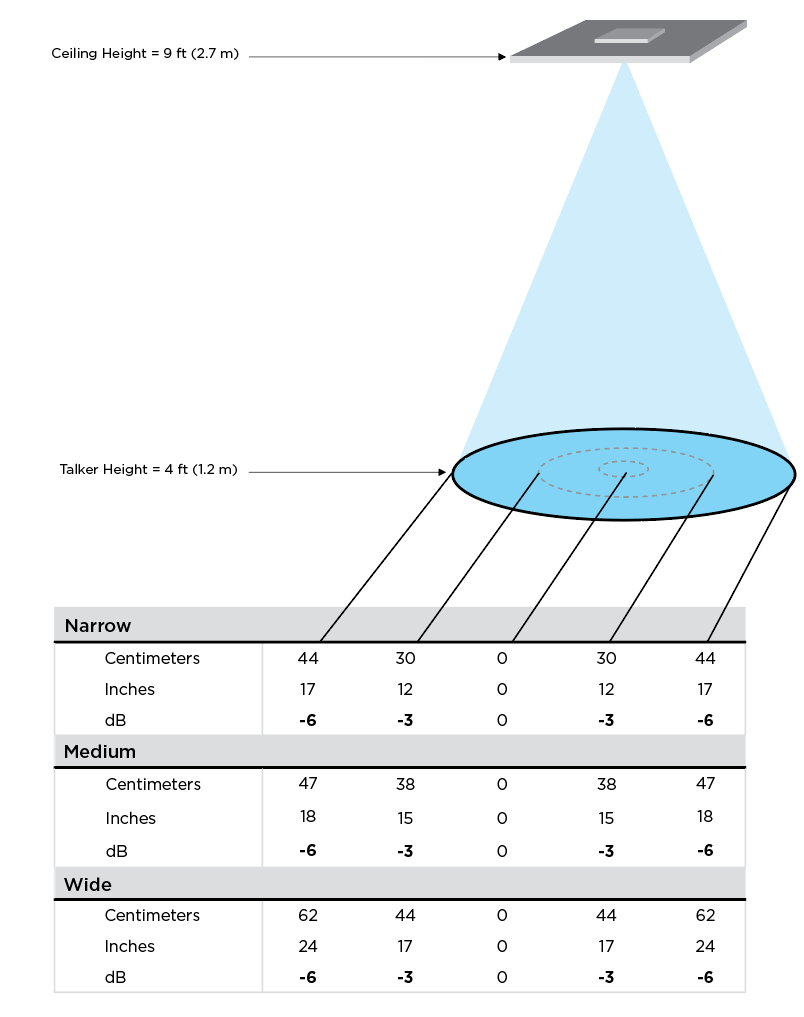Welcome to part three of our series on beamforming microphones and use cases for lobe aiming. In this segment, we’ll discuss microphone placement and lobe aiming.
Microphone Placement
Typically, designers consider speaker placement first for uniform coverage of a room (refer to the InfoComm and ANSI specifications). However, there’s a strong argument that microphone or mic array placement is just as important, if not more so, for uniform mic coverage (although no standard exists yet).
Optimal beamforming microphone placement is guided by the typical seating arrangement within the room. Consider these suggestions when determining mic installation for the best possible results:
- In rooms with flexible furniture arrangements or multiple beamforming microphones, map out all of the possible seating scenarios to ensure that coverage will be adequate for each.
- Lobes should be pointed towards the front of each talker (think of a lobe as a spotlight on the face of a performer). Carefully consider placement in rooms where talkers may face a screen during a video conference.
- Identify the maximum recommended distance from the beamforming microphone to a talker before designing the room.
- Avoid installing the microphone directly next to unwanted sound sources, such as air vents or video projectors.
- Consider installing acoustic treatments to improve speech intelligibility in rooms that are too reverberant.
- The pickup pattern of a beamforming array can be narrower than a shotgun microphone, and therefore it can sometimes be placed farther from the source than other types of microphones.
- Keep in mind that there is no specific barrier at which the pickup audio degrades or gates off.
- Like all microphones, tonality changes as the distance from the source increases.
- The lobe coverage area increases as distance increases.
Aiming Lobes
Think of each lobe as an individual virtual microphone. If there were eight microphones on the table, each one could be physically placed according to seating arrangements, with independent gain and channel controls. Independent width control makes it possible for some lobes to capture individual talkers (narrow), while other lobes cover multiple talkers (wide). A note of caution: even though the above analogy makes it appear that beamforming microphones can be used for voice lift/local reinforcement applications, it is not recommended.
Consider these suggestions when aiming lobes for the best possible results:
- Use speech as the sound source; do not use test tones.
- Eliminate noise sources in the room if possible, such as projectors or fans.
- For the best acoustics, talkers should not be directly against a wall or in a corner, as acoustic reflections can reduce aiming accuracy.
- Speak from the exact location where the lobe should be positioned.
- Each lobe can be used to pick up one or more talkers, so the concept of “less is more” should be kept in mind.
- If a lobe needs to cover an area with multiple talkers, talk from the center of the region. Manual adjustments may be necessary after the lobe is positioned to ensure the entire area is covered.
- Any unnecessary lobes should be deleted.
- As the lobe width is set tighter, side lobes become more prominent. In some applications, it may be better to use medium or wide lobes depending on the desired results.
- Provide complete coverage in a space, either by adding lobes or by changing the lobe width. This ensures the sensitivity is within 6 dB in all areas.
- Ensure that spacing and isolation are adequate to reduce noise and maximize automatic mixing performance. However, it is acceptable for lobes to slightly overlap.
Here are some additional reference measurements that may aid in aiming or confirming aiming of microphone lobes:
- The average conference room table is 30″ Above Finished Floor (AFF).
- The average height of a talker’s mouth is 48″ AFF when in the seated position.
- The average height of a talker’s mouth is 60-66″ AFF when in the standing position.

Figure 7: Approximate widths of narrow (35°), medium (45°), and wide lobes (55°). Note that down-firing lobes are not effective, as the talker will be speaking approximately 90° off axis. Most lobes will be more accurately represented as an ellipse as opposed to a circle.
Stay tuned to Component for the fourth and final segment in this series, which will focus on use cases for lobe aiming.
